
(Click here to read reviews of this album!)
This page is devoted to Liza Minnelli's ninth album (and third live album), Live at the Winter Garden.
Live at the Winter Garden was recorded over January 6 - 8, 1974 at the Winter Garden Theater in New York City. It was released by Columbia Records in May 1974 as LP #PC 32854; it was originally known as just Liza (probably thanks in part to the cover artwork), and later changed to Liza Minnelli at the Winter Garden. It finally saw a CD release on May 8th, 2012 by Sony Masterworks; #194196. It was produced by Gary Klein, the remote engineer was Phil Ramone, and the remix and editing engineer was Don Puluse. Ralph Burns arranged the overture; Billy Byers arranged the tracks "If You Could Read My Mind/Come Back To Me", "Shine On Harvest Moon", "Exactly Like Me", "The Circle", "And I In My Chair", "There Is A Time", and the curtain bows music; Jack French arranged "More Than You Know", "A Quiet Thing", and "Anywhere You Are/I Believe You"; Jonathan Tunick arranged "I'm One Of The Smart Ones"; Bill Reddy arranged "Natural Man" and "I Can See Clearly Now"; and Peter Matz/Fred Werner arranged "Cabaret". The location recorders at remote recording facilities were Aaron Baron and Larry Dahlstrom, and the recordists were Hank Altman and Tom Dwyer. The orchestra personnel manager was Earl Shendell; and the orchestra itself consisted of Arthur Azenzer, Frank Bruno, Norman Jeffries, Don De Marco, and Jack Cavari on rhythm; Al Di Risi, John Frosk, Lew Gluckin, Ronald Keller, Vincent Fanuele, Wayne Andre, and Fred Zito on brass; Al Ragni, Dennis Anderson, Lewis Del Gatto, and Walter Kane on woodwinds; Max Cahn, Tobias Bloom, Joseph Goodman, Marie Hence, Elmar Ollveira, Ian Wint, Sandra Robbins, Nina Simon, Maurice Brown, and Bernard Fennell on strings, and Eric Cohen and Charles Roeder on percussion. The album cover illustration was by Joe Eula; the back cover photos were by Arthur Maillot and Robert Deutsch; and the back cover was designed by Karen Lee Grant. The CD re-issue also includes David Foil as the reissue producer; mastered by Mark Wilder at Battery Studios; Roxanne Slimak as art direction; Long Vu for design; photography by Arthur Maillot; Leslie Collman-Smith and Scott Farthing for marketing; and Tom Laskey for product development. The concert personnel credits read as follows:
THE SHUBERT ORGANIZATION in association with RON DELSENER presents LIZA MINNELLI with
PAM BARLOW -- SPENCER HENDERSON
SHARON WYLIE -- JIMMY RODDY
DIRECTED BY BOB FOSSE
WRITTEN BY FRED EBB
CHOREOGRAPHED BY BOB FOSSE & RON LEWIS
ORIGINAL MUSICAL MATERIAL BY FRED EBB & JOHN KANDER
MUSICAL COORDINATOR -- MARVIN HAMLISCH
MUSICAL CONDUCTOR -- JACK FRENCH
LIGHTING DESIGNED BY JULES FISHER
AUDIO DESIGN -- PHIL RAMONE
SOUND BY STANAL SOUND
PRESENTATION CORDINATED BY BILL LIBERMAN
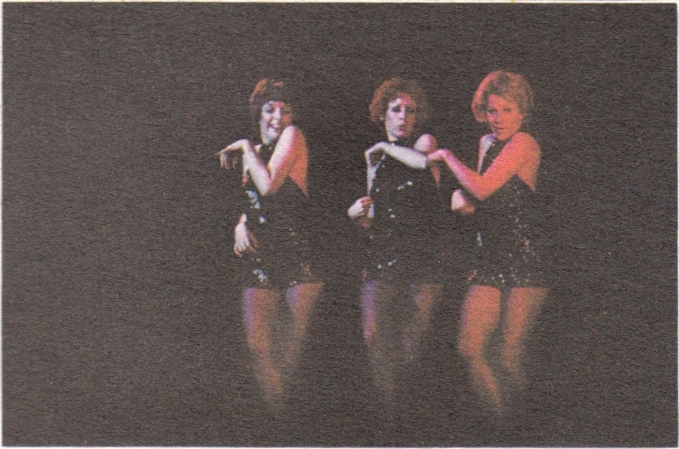
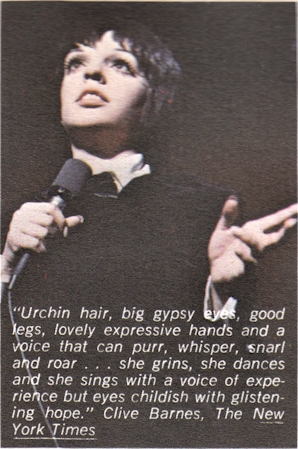

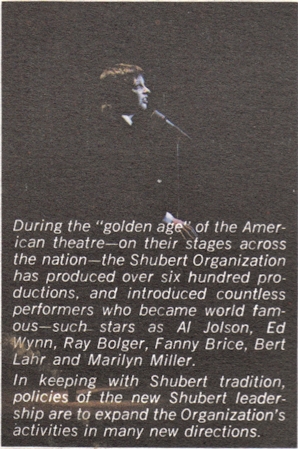
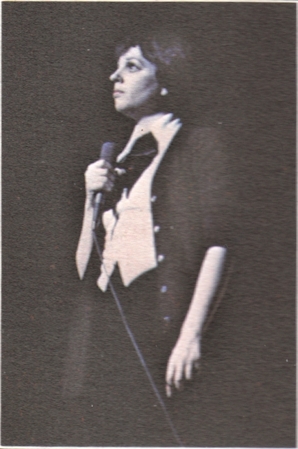


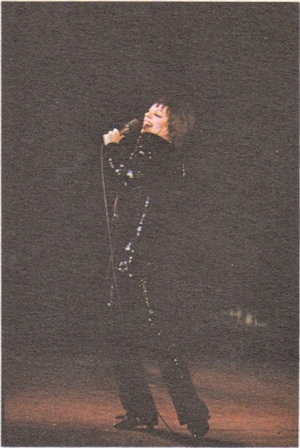


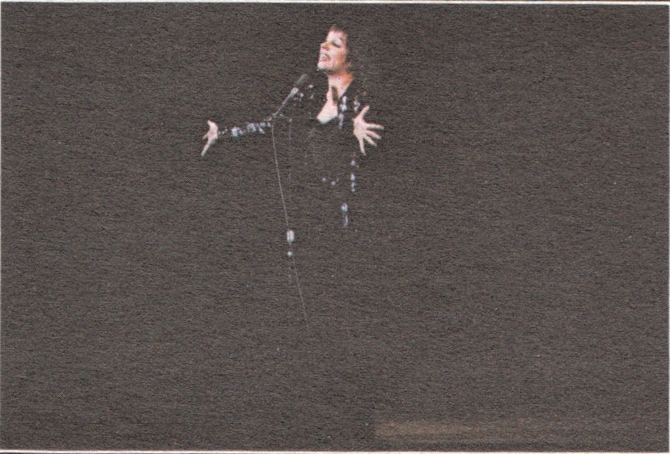
(Photos from back of the LP jacket. Click thumbnails to enlarge.)
The back cover of the original LP album bears the following two inscriptions:
"Urchin hair, big gypsy eyes, good legs, lovely expressive hands and a voice that can purr, whisper, snarl and roar . . . she grins, she dances and she sings with a voice of experience but eyes childish with glistening hope." Clive Barnes, The New York Times
During the "golden age" of the American theatre--on their stages across the nation--the Shubert Organization has produced over six hundred productions, and introduced countless performers who became world famous--such stars as Al Jolson, Ed Wynn, Ray Bolger, Fanny Brice, Bert Lahr and Marilyn Miller.
In keeping with Shubert tradition, policies of the new Shubert leadership are to expand the Organization's activities in many new directions.
Although the original show this album hails from was 2 hours long, only 53 minutes' worth of it ever made it to the original LP album (which is a shame, if they'd just done a double album, they could have fit it all in), and 68 minutes made it onto the newer CD re-release. The full, unaltered setlist for this show went as follows:
The full engagement ran twenty four performances from January 6 - 26, 1974, plus a special midnight performance on Friday, January 25th, for the Actor's Fund. That performance was videotaped on black and white film, shot with two cameras (much as Liza With A Z was). The tape can currently be viewed at the Theatre on Film and Tape Archive; a division of the New York Public Library for the Performing Arts. Liza agreed to pay half the cost after she, Fred Ebb and John Kander taped a 50-minute interview on January 14, 1974. The January 25th filmed performance was also made part of the Stanley Prager Memorial Collection, part of Lincoln Center's Library. There were also silent color home movies made during this engagement that exist as well. This special performance was a benefit that raised more than $20,000 for the Actor's Fund, and at the end of the show, Liza was presented with an Actor's Fund citation as a thank you for her contributions from drama critic Clive Barnes. It was a star-studded night, and Liza was overwhelmed by all the applause.
Liza boasted that the Winter Garden shows would be an event never before seen in the history of theater. It would be 90 minutes of song, dance, and knock-'em-dead pizzazz. It would be sheer energetic entertainment. There would be no opening act; simply Liza, live. It would be her first Broadway one-woman show. Within 36 hours of going on-sale, the tickets for the entire three-week engagement sold out, and grossed a record $413,815, of which Liza received $300,000 (which was more money than any other entertainer had ever earned at the theater). Within days, scalpers were selling the $15 dollar tickets (for the best seats!) for skyrocketing profits, sometimes as much as $200 a piece; an unheard of prospect in those days. As usual, the tickets were mis-printed and beared the name "Lisa Minelli", and have since become collector's items. ("Can you believe it?!" Liza shrieked.) Given today's inflated cost of concert tickets, $15 doesn't sound like very much, but back in 1974, many people -- including Douglas Watts of the New York Daily News, found the $15 price tag to be "outrageously high." (In 1977, The Act would set another theatre precedent with its top-priced $25 tickets.) Tom Buckley wrote in the New York Times: "The show is generating the kind of electricity in this energy-starved theater season that can't be provided by all the oil of Araby. For one thing, it will be Miss Minnelli's first appearance here since her Academy Award for Cabaret and her Emmy for her 1972 television special made her an international star. For another, she returns as a hometown girl who made good. Ever since she decided in her mid-teens to seek a career in the theater, the city has been her home. Most of her oldest and closest friends and advisors live here." To which Liza responded, "It's a terrific city. it's still the Big Apple. I like it better every time I come back."
Liza wanted to make certain that nothing would go wrong with this show. She spents weeks rehearsing, and surrounded herself, onstage and off, with only her most trusted of friends. Jack French, who'd worked with Liza since 1966, would conduct the 28-piece orchestra; Deanna Wenble would handle the scores of lighting cues; Marvin Hamlisch would serve as musical coordinator; Fred Ebb would write the show; Nancy Barr would help handle Liza's quick costume changes; and Bob Fosse (who Liza had been currently dating at the time) would direct. The show certainly looked like a winner. This was also the first Manhattan stage appearance Liza would be making since Flora, The Red Menace nine years earlier. A gigantic marquee billboard emblazoned with giant red letters screaming "Liza" spanned the top of the Winter Garden Theater, running almost one entire city block in length. The graphic lettering by Joe Eula was simple and effective, and he dotted the "i" in Liza with a drawing of the diva. (Eula would also later create the advertising motif for The Act.)
The anticipation of the show was mounting throughout the city, especially since another star, Bette Midler, had opened to highly praised reviews just a month earlier. In her anxious nature, Liza worried that Bette's act might outshine hers. Not wanting to be upstaged, she purchased tickets to the December 23rd performance at the Palace Theater -- the closing night of Bette's show -- and in that evening, Liza's fears were put to rest. While Liza loved Bette's campiness and polished vulgarity, she knew that both their respective shows were two completely different species. There would be no comparison between them.
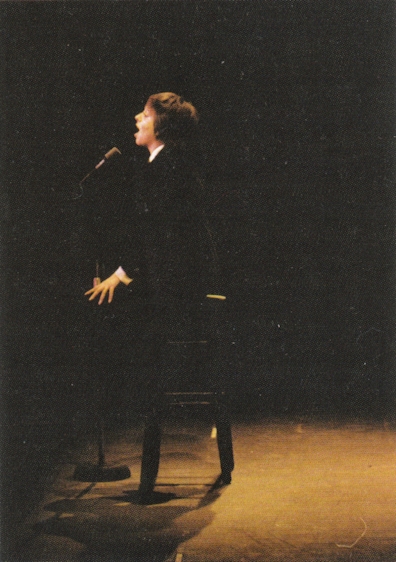
The show opened on Sunday, January 6, 1974, and Liza and Fred Ebb went through the same pep talk they always had since the beginning of their working together since 1965 at the Shoreham Hotel. Ebb said, "What I always tell her is you can't presume on audiences. You can't let yourself think success is your due; you've got to earn it; your energy level and your desire to please must always remain high." She had nothing to worry about; those opening night ticketholders were rewarded with a Liza show that overwhelmed them. She blasted the audience with her high-octane opening number, "Say Yes", followed by a singing and dancing experience that delighted all. The performance was a breathless display of her versatility and diverse facets of her talent. For starters, like Judy, she was obsessed with choreographing every movement, every song, every setting, every step, and every element of the performance. That attention to detail is crucial for producing a quality performance that stays consistent show after show. She also insisted on the best production people she could get and only those who understood her.
Some of the first-nighters included Betsy Palmer, Dudley Moore, Vincente Minnelli, Lorna and Sid Luft, Kay Thompson, Fred Ebb and John Kander, Bob Fosse, Kitty Carlisle Hart, Ben Vereen, Henry Kissinger, Halston, Diane Von Furstenberg, Neil Simon, and Mayor Beame of New York. From start to finish, Liza was a breathtaking powerhouse of talent. Each number was highly stylized and vocalized. However, much to the chagrin of the theatre afficianados, Liza and her quartet of dancers committed a major musical theatre faux pas by lip-syncing to several songs, including "Natural Man". (She would commit the same faux pas again three years later, to great criticism, when she starred in The Act.) "We decided to lip-sync because we had no other choice," Liza explained. "There were numbers people wanted to really see -- especially 'Ring Them Bells' -- and I just couldn't do that huh-huh, panting kind of singing as I danced." On Saturday nights during the engagement, there were two shows a night; one at 7:30 pm and one at 10:30 pm. On Sunday nights, there were also two performances; a matinee and an evening show. An audio tape exists of one of the Saturday night performances. She even got down on one knee and sang "My Mammy", which hadn't been done there since Al Jolson had done it. (He would've regarded it as chutzpah.) The audiences thought it was terrific. The similarities of the old star of the past and the young one of the present weren't lost on the audience; a sprinkling of whom had seen the original artist performing that same exact number and could attest to the fact that the amount of applause in 1974 wasn't too different from that heard there 45 years earlier. While there were modern songs in the show such as "Cabaret" and "I Can See Clearly Now", a good deal of the repertoire was from the 'Mammy' era of songs, like "Shine On Harvest Moon" and "Bye Bye Blackbird". Over the course of the evening, with its single intermission, Liza never seemed to stop. She pummeled patrons with song after song, dance after dance. She occasionally had to sit on a stool to catch her breath, but she never lost the frantic pacing that is so ingrained in her performing personality. She utilized clever banter to bridge the song numbers and to assure the audience that although she may be sweating, she was really having a good time and that she was happiest whenever she was pleasing an audience. Par usual, she sold herself to her fullest ability.
Following that opening night performance, more than 300 people packed into the Rainbow Room Grill, where Vincente Minnelli, Columbia Records and the Shubert Organization hosted an Italian buffet in Liza's honor. She arrived on the arm of her father a little after 10:30 pm, looking every bit the woman of the hour. She was dressed in a fox jacket, wide-brimmed polka-dot Borsalino hat, and a white tuxedo jacket, which hid her black and white polka-dot pantsuit. For the occasion, Liza's ensemble was designed by Jacques Bellini; not Halston, her usual designer (who was also at the event). When Liza walked in, she looked slightly startled and exclaimed, "You're all super. Thank you very much!"
Critics adored the show. Clive Barnes of the New York Times wrote, "Liza makes it seem like it's summer again, and in every respect, Liza is a winner. It is probably her nervousness, those stretched-out moments of the spirit, that make Liza's performance so exciting. Her vitality is unusual. It is not the sheer powerhouse drive of some singers, but rather the result of some exciting internal tension. It is compulsive and, for all its ease, a little agonized. She has a voice that can purr, whisper, snarl, and roar. Her ability to act in singing was suddenly once again made luminous. She reminded us this was not just a girl who could belt out 'Cabaret' to make juke-box bonanza, but also acted the closest thing to Isherwood's Sally Bowles seen on stage or screen. She's also very sexy in an old-fashioned way that I was beginning to think went out of style. But why only three weeks, Miss Minnelli? Stay longer next time, and then even the management will spell your name right on the tickets." Anthony Mancini from The New York Post wrote: "Liza has a clarion voice and her songs urge us -- against the odds -- to drink long drafts of life. She carries it off because of her ability to create a bond of instant intimacy. She dances like a colt and most of the time (even with her four dancers), it's just Liza with a Z and alchemy." Robert J. Landry wrote in Variety: "Not just a song and dance girl but also an actress, getting a lot of her effects facially and through body English, she has a piquant mixture of confidence and diffidence, of wham and subtlety. . . Everything hung together. The faithful were not disappointed. The squares gave in. The engineered hot-rod pace never slackened. It was show business at its professional best." Douglas Watts was a bit more critical, but still mostly praising. "Miss Minnelli comes to us in black and white. Besides the extremely attractive velvet little boy suit, she wears a grayish metallic gown, cut above the knees in front and sweeping the floor in back, and a shiny black miniskirted dress for some of her nimble dancing. Liza proves to be an engaging, but far from magnetic, entertainer. And, for whether or not she and her groomers care to admit it, the image of the plucky Judy Garland is never far off, particularly when, in a velvet suit with knee britches and patent-leather pumps, Liza slams home with 'Mammy.' She unavoidably calls to mind Judy's 'Rock-a-bye Your Baby With A Dixie Melody.' Liza, even with all her tremendous energy and appeal, is not yet a Sinatra or Streisand." He went on to further write, "Winning though she is, Miss Minnelli's turn palls long before it is over as the carefully manufactured aura of triumph becomes cloying. She is brimming with health, energy and enthusiasm and she is undeniably talented. Now all she needs is a little fresh air."
The album won a Tony award for Best Personal Achievement, and it debuted on Bilbboard's Top 200 charts on May 18th, 1974, where it stayed for four weeks, peaking at number 150. However, it wasn't long before Columbia put the kibosh on the album; it violated a contractual agreement by including songs from Cabaret in the show, which was then a still current soundtrack album. Just as quickly as it had come galloping in, it fell from sight until 2012's re-release. According to the CD booklet, the first of the three bonus tracks, "You and I", was recorded on January 8th, 1974, while the other two bonus tracks, "It Had To Be You" and "My Shining Hour" were recorded on February 2nd, 1974. While the booklet boasts that "all tracks recorded live at the Winter Garden Theater, New York, NY", this is actually untrue. From January 30 - February 12, 1974, Liza was performing engagements at the Riviera Hotel in Las Vegas... very much not the Winter Garden.
The bottom of the LP also had a quick mention of Liza's fan club: THE LIZA MINNELLI FAN CLUB, "LIMELIGHT ON LIZA", 225 AWOSTING ROAD, HEWITT, NEW JERSEY 07421. (It has since been closed in recent years, but you can still sometimes find fan club publications floating around on Ebay.)
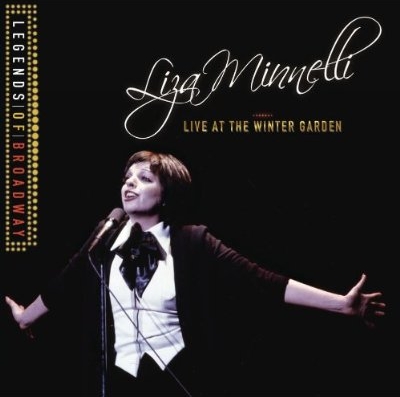
(Cover of the CD re-release)
The inside of the CD booklet reads:
Liza Minnelli and Broadway were made for each other. Minnelli, of course, is Hollywood royalty -- not just everyone makes a film debut at the age of fourteen months (with her mother Judy Garland in In The Good Old Summertime) -- and she has an Oscar to her name, just like both of her parents. But it is on Broadway that she made perhaps her most distinctive mark, where her stage persona began to take shape and where she has returned throughout her career to rediscover her adoring public.
Liza Minnelli Live at the Winter Garden captures what may be the best of those memorable visits, in January of 1974. Minnelli was already a Broadway veteran then, having won the Tony Award for Best Actress in a Musical in 1965 for Flora the Red Menace, when she was 19. The show was not a hit but she was, suddenly an exuberant, irresistable, somehow fragile diva whom the world wanted to embrace. Four years later, she had her first Oscar nomination for The Sterile Cuckoo, and in the spring of 1973 the Oscar itself for her performance in Bob Fosse's film of Cabaret. She added an Emmy (for the Liza with a "Z" TV special) that May.
At the crest of that incredible wave -- she was all of 27 years old in January 1974 -- Minnelli returned triumphantly to Broadway to hold court at the Winter Garden for a month of performances, captured on this long-available live recording. The concept was simple: "just" Liza with four dancers (two men, two women), a band and some great songs, old and new. Bob Fosse staged the show and choreographed it with Ron Lewis. Since the beginning of all their careers, Minnelli has been a virtual muse to the composer/lyricist team of John Kander and Fred Ebb, and they supplied new material for these performances.
The show was a blockbuster hit, selling out the entire month's run in one day and setting a hosue record for the Winer Garden Theater. In the New York Times, critic Clive Barnes rhapsodized about Minnelli's "urchin hair, big gypsy eyes, good legs, expressive hands, and a voice that can purr, whisper, snarl, and soar." Years later, in a New York Times interview, Meryl Streep would recall discovering an important truth about performing from the Winter Garden show, which she saw when she was a studen at Yale. "I learned something from watching Liza Minnelli," Streep said. "Encountering and truth-telling are the initial steps of acting. But there is a further leap to the understanding of the importance of brilliance, sparkle and excitement. 'Performing' is the final gloss." At the end of the season, Minnelli was awarded a special Tony Award for the Winter Garden show.
Columbia Records' original April 1974 LP release of Liza Minnelli Live at the Winter Garden had to be withdrawn because of contractual conflicts over Minnelli's performance of songs from the Cabaret score, infringing on the then-current soundtrack album. Until now, the Columbia recording was out of circulation, except in pirated versions. Accept no substitutes: this long-awaited re-issue is derived from the original master, engineered by Phile Ramone. Included here are three tantalizing live bonus tracks from the show that were not included on the original LP but turned up amid the vast amount of live material recorded for the album -- Stevie Wonder's then-new "You and I" and two glorious standards, "It Had To Be You" and "My Shining Hour." That last title might be the best description of this unforgettable evening. -- David Foil
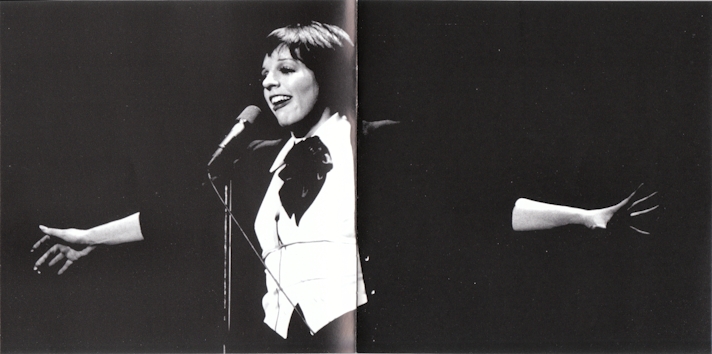
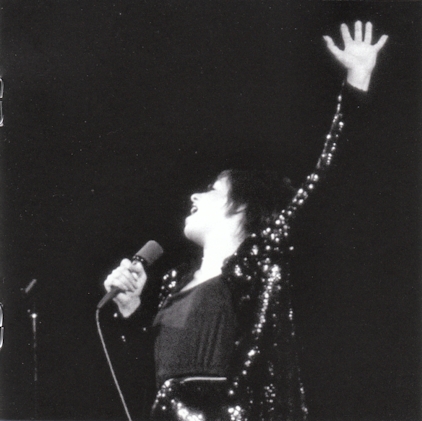
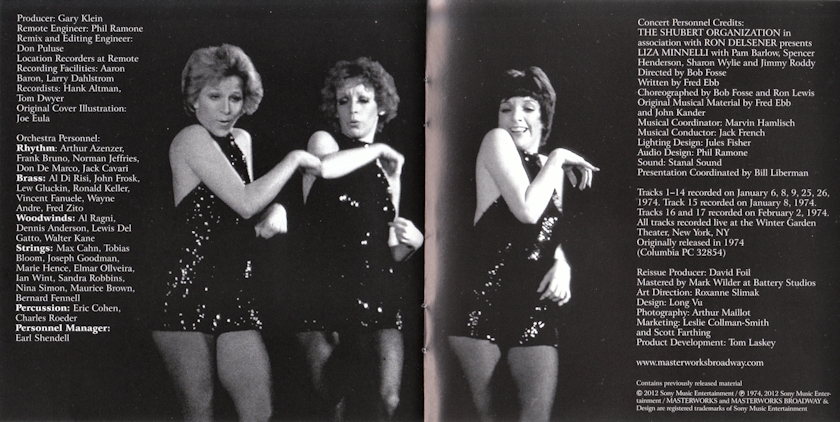
(Photos from inside the CD booklet. Click to enlarge.)
1. Overture: Liza with a "Z"/Ring Them Bells/I Can See Clearly Now/Maybe This Time/Cabaret (Fred Ebb, John Kander, Johnny Nash) (instrumental)
2. If You Could Read My Mind/Come Back To Me (Burton Lane, Alan J. Lerner, Gordon Lightfoot)
3. Shine On Harvest Moon (Nora Bayes, Jack Norworth)
4. Exactly Like Me (Fred Ebb, John Kander)
5. The Circle (Fred Ebb, Edith Piaf)
6. More Than You Know (Edward Eliscu, Billy Rose, Vincent Youmans)
7. I'm One Of The Smart Ones (Fred Ebb, John Kander)
1. Natural Man (Sandy Baron, Bobby Hebb)
2. I Can See Clearly Now (Johnny Nash)
3. And I In My Chair (Et Moi Dans Mon Coin) (Charles Aznavour, Fred Ebb, David Newburge)
4. There Is A Time (Le Temps) (Charles Aznavour, Jeff Davis, Gene Lees)
5. A Quiet Thing (Fred Ebb, John Kander)
6. Anywhere You Are/I Believe You (Fred Ebb, John Kander)
7. Cabaret/Curtain Bows (Fred Ebb, John Kander)
8. You and I (Stevie Wonder) *
9. It Had To Be You (Isham Jones, Gus Kahn) *
10. My Shining Hour (Harold Arlen, Johnny Mercer) *
* denotes did not appear on the original album release